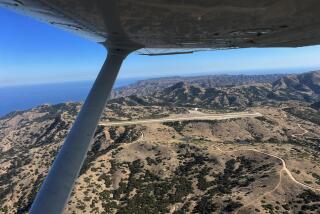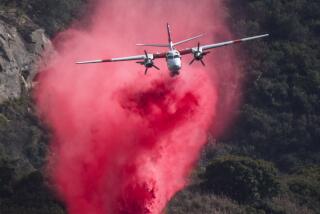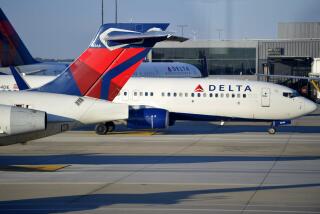Therapists Bring Color to Those White Knuckles
- Share via
For nearly 25 million Americans, the blazing crash of Northwest Airlines flight 255 in Detroit on Aug. 16 was nerve-fraying confirmation of their worst fear: That when they board a plane, the chances are good that the plane will crash and they will die.
Never mind that almost eight times as many Americans die in a single year while walking than are killed in passenger jet crashes in a decade.
Never mind that a jetliner about the size of a Boeing 727 would have to crash without survivors every day, seven days a week, to kill as many people as motor vehicles do in a year.
Never mind that the 1-in-3-million chance of being killed on a commercial flight makes the 1-in-133 chance of being murdered look a lot creepier.
Never mind all that. White-knuckle fliers know their plane is doomed.
Glen Arnold has watched that paralyzing fear develop, mostly secondhand. Arnold, a behavioral therapist who is also a commercially rated pilot, is the director of Newport Beach-based ThAIRapy, an offshoot of his practice dedicated to treating the fear of flying.
For more than a decade, Arnold has been helping his patients do battle with the demons that come out only in the air. And the specter of Flight 255 can turn many millions of knuckles even whiter, he said, even if the fearful millions don’t immediately seek help.
“After a crash . . . it won’t necessarily set the phones ringing in fear-of-flying clinics,” Arnold said. But with people who already are afraid to fly, an airliner crash can confirm, even exacerbate their fears, giving them a chance to say “ ‘You may think I have a phobia, but look what happened yesterday!’ ” he said.
One out of every six adult Americans--or about 25 million people--are afraid of flying, according to a 1980 study of the problem by the Boeing Co., the Seattle-based airplane manufacturer.
The catalogue of fears that can bedevil a fearful flier are almost endless, according to Layne Ridley, author of “White Knuckles,” a book about fear of flying that Arnold uses as a supplemental text in his group seminars and in sessions with individuals.
There’s the worry about the person behind the controls. If confirmed white-knucklers see that a pilot looks tired, they may think he was out on a drunken, all-night debauch. Or maybe that he’s still drunk, or incompetent, or even an impostor.
They worry about what the whine of the flaps on takeoff means. Will the wing fall off? And that thump when the landing gear retracts--is it just a thump, or is it a hatch cover blowing off--and is that enough to cause a person to be sucked out of the plane?
Will the air turbulence shake the plane apart? And that calm air--is it really the eye of a storm, or is it an enormous hole in the sky through which the plane will surely plunge?
Does the descent mean trouble? Is it too fast, uncontrolled, or could the plane be losing power?
When landing time finally arrives, “you don’t have to worry about falling any more,” Ridley writes in her book published this year by Doubleday & Co. Inc. “Now all you have to worry about is crashing into the terminal and wiping out your loved ones.”
Still, although the breadth of the anxiety may seem limitless, it likely isn’t flying itself that’s causing the clammy sweats, Arnold said.
Fears are learned, said Arnold. “And there are two categories of fear: Direct experience, which can be the result of, say, a turbulent flight; and indirect experience. When it’s indirect, it can commonly come from parents who have a fear of flying--where the parents will tell their children that life is laced with fear, or to be careful of this or that--or from family members or friends. A small percentage of people pick it up that way, by osmosis, though. Most get it from direct experience, and the first flight can set the conditioning behavior.”
But is it really fear of flying? Behavioral counselor Fran Grant of San Mateo says the phobia is more properly broken down into subcategories such as claustrophobia; a fear of lack of control; a fear of being unable to control one’s behavior in flight; a fear of separation from family and friends, or, simply, a fear of fear. And, of course, there is fear of heights.
“Fear of flying is just one of many individuals’ personal problems,” said Grant, director of Fear of Flying Inc. “It will be something that the person has known about for years. And those fears become enhanced in their degree when people are flying.”
Grant said her clinic has averaged 10 to 20 calls a day since the Aug. 16 crash, but generally the callers were graduates of her program “calling for a feeling of comfort.”
Both Grant and Arnold say most people who have come to them to conquer their fear of flying generally aren’t prodded to action by a specific event, such as the Northwest Airlines disaster, which killed more than 150 people.
Rather, they said, the fear has usually gnawed at them for years, and for some reason--often a job change--they find themselves having to get on airplanes more frequently.
‘Intricate Web’
This madhouse of fears “can get to be an intricate web with some people,” according to Arnold.
For instance, a salesman flying to San Francisco to be rewarded for a job well done may barely notice turbulence, he said. “But if he’s going there to be called on the carpet by his boss, the turbulence is a reflection of his vulnerability, and he can become frightened.”
Turbulence, said Arnold, “is one condition that affects just about everybody. If you stand in the back of a plane (in) heavy turbulence . . . and look up the aisle, you can see heads turning everywhere. People are looking around, trying to get reassurance from each other. But turbulence is a natural occurrence in the ocean of air. On the ground, we call it wind. It’s not an alien, hostile force, like being burglarized.”
The “ocean of air” analogy is one Arnold uses to help his patients understand and better cope with their fear. Physics and mechanics of flight also are components of a treatment program that makes use of deep relaxation techniques. Even in the age of space exploration, he said he has found that many fearful fliers are ignorant of the basic principles and mechanics of flight.
“Even though a million people a day are being transported on commercial carriers, flying is relatively new to the majority of people,” Arnold said. “It began in this century, and no real guidelines for airline passengers were ever set down. No one ever knew what to expect out of flight. It’s still like that--essentially, you’re on your own when taking a flight.”
As Ridley, himself, said in his book, “Fear . . . is a perfectly sensible response to being propelled at great force into the air and suspended mysteriously at a terrific height, utterly at the mercy of a roaring machine you know nothing about, and with no way out but way, way down.”
What, then, can the jittery passenger do to smooth out the mental turbulence while the real thing is bouncing the plane around?
Arm yourself with knowledge, quit trying to keep the plane up by sheer force of will and leave the flying to the crew, and relax, said Arnold.
What to do about takeoff jitters? “Takeoffs dramatically slam home the fact that you are out of control,” he explained. “They generally take about 30 to 40 seconds. If you take three long, deep breaths over that time, you’ll go into the air more relaxed.”
What about in-flight fright? “People anticipate and monitor noises and go through a checklist of possibilities,” he said. “You can deal with it by delegating responsibility. You can’t control the exterior conditions, so delegate them to the people who are most capable of taking care of them: the crew.”
When it comes to in-flight turbulence, Arnold recommends disassociating oneself with the bumping plane. Instead of grabbing the armrests, which he said is the typical response, “let go of the armrests and try to visualize yourself as being like a bowl of Jell-O.”
And, he added, don’t drink. “People are surprised when they find the alcohol has no effect on (their fears).” Yet the depressant effect of the booze catches up with them at the end of the flight all the same, he said.
Even veterans of the sky get the jitters, say the therapists. Arnold said he once treated a flight attendant who later confessed her fear of turbulence to her co-workers and found that she wasn’t alone with her dread of bumpy air. Another patient who was frightened as a child by his pilot uncle’s erratic flying eventually overcame his fear to become an aerobatic pilot.
Fear Not Fear at All
And sometimes, Arnold said, fear isn’t fear at all. He told of one patient, a man who refused to fly to Hawaii with his wife and daughter.
“His wife and daughter told me he had a flying problem,” he said, “but as it turned out, he just didn’t want to go to Hawaii. He wanted them to go without him. He loved being at home alone, being left to do whatever he wanted. It really wasn’t a fear of flying. He just wanted to stay home and cook fried liver.”
Finally, for those who do want to fly, Ridley points out that while National Transportation Safety Board statistics show that 1,442 people were killed in U.S. airline accidents between 1974 and 1985, U.S. carriers safely ferried more than 3.3 billion passengers on about 61 million scheduled flights.
More to Read
Sign up for Essential California
The most important California stories and recommendations in your inbox every morning.
You may occasionally receive promotional content from the Los Angeles Times.










